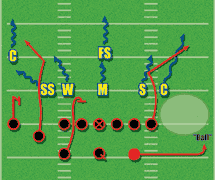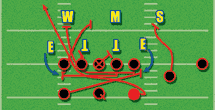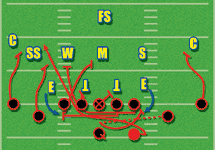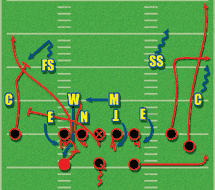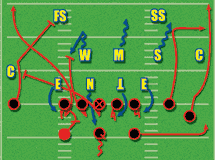Article CategoriesAFM Magazine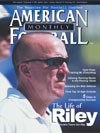
|
Scorching the CompetitionValdosta blazes D2 by utilizing RB\'s in the passing gameRunning backs coach, Valdosta State University © More from this issue
Whenever I tell people that I coach the running backs at Valdosta State, they kind of look at me funny and jokingly say, “VSU doesn’t run the ball!” Well, it’s true ... Blazer Football is known throughout the country as one of the premier passing teams. Our former quarterback, Dusty Bonner, won back-to-back Harlon Hill Trophies (Division II’s TOP player). As a junior, he threw for 4,126 yards and 55 TD’s, with a 71.9 completion percentage, and as a senior he threw for 4037 yards and 52 TD’s with a 70.1 completion percentage.
However, what makes the offense truly successful is having the
ability to have the patience to take what a defense gives you. That
means to run the ball when the defense gives you the proper numbers
in the “box” and also to “dump” the ball
off to the backs in the passing game and let them make plays. We
also have several passing plays (screens) designed for the running
backs. Our offensive philosophy is to “throw the ball short
to people who score.” Our starting running back led the conference
in 2001 with 21 touchdowns. He also broke the school record with
1,503 yards rushing (7.6 average/carry) and was third on the team
with 47 receptions for 583 yards (12.4 average/catch). Incidentally,
our No. 2 running back also had 17 receptions for 181 yards.
One of the simple things that we do is teach our backs to make a “ball” call if they run a route and have 10 yards or more of open grass in front of them. Several times defenders drop deep into coverage, leaving the backs wide open in the flats. The QB is taught that when he hears the “ball” call, he will turn and throw. This sounds simple, but you have to make them understand that the quarterback is trusting them and they have to be sure whenever they make the call. This is an easy way to utilize the backs and to “take what a defense gives you.” What could be better than to get the ball to your best ball carrier in the open field? An example of one of our basic plays is drawn below (Diagram 1) with the defenders dropping off and the back making a “ball” call in the flats. SHOTGUN COUNTER
Last season, one of our most effective run plays was the counter.
We ran it out of the shotgun, with one or two backs in the game.
Up front, we block back on the playside and pulled from the backside.
One difference, since we are primarily a passing team, the playside
OT pass sets briefly to get the DE up field before he heads to his
LB. This helps with the kick-out block of the OG. The QB gets the
snap, jab fakes to the first back who is responsible for the backside
DE and then reaches to give to the other RB. See (Diagram 2).
• First back must stay tight to the pulling OT. He cannot
let the DE beat him across his face.
The back getting the ball will set up and get lost behind the playside
OG. If his blitzing linebacker comes, he will “lose him”
or “sucker block” him to the outside, turn and get the
INSIDE SCREEN from the QB. If his assigned blitzer does not come,
he will hide behind the OG and be patient. We tell him to not turn
until the OG and center release. (See Diagram 4).
The playside WR will push/crack on the Safety. All other WR’s
will run a pass route to get the defenders to drop. A key to the
play is to make sure the RB finds the alley to the outside. The
QB will drop looking to his strong side. He takes three steps and
a hitch step. He will then gather his feet, give a little more ground
and dump it over the rush to the back on the INSIDE SCREEN. See
(Diagram 5). About the author: Chris Boden Chris Boden began his seventh full season on the Blazer football staff in 2002 and is working under his third head coach, having joined Hal Mumme’s program in the spring of 1996 as quarterbacks coach. Like Mike Kelly before him, Hatcher was impressed with the job Boden did in the recruiting area during the coaching staff transition and retained him as recruiting coordinator, later adding more responsibility as director of football operations. He took charge of the running backs during the spring of 1997 and will continue to coach that position this fall. A native of Tawas City, Michigan, Boden was a quarterback at Saginaw Valley State (MI) University in Saginaw, graduating in 1990. He began his coaching career as a graduate assistant at Central Michigan University, working with the secondary for two seasons and earning his master's degree in 1994. |
|
| HOME |
MAGAZINE |
SUBSCRIBE | ONLINE COLUMNISTS | COACHING VIDEOS |
Copyright 2024, AmericanFootballMonthly.com
All Rights Reserved


